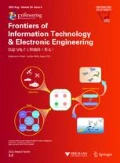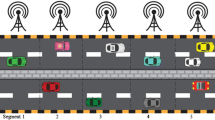Abstract
We analyze the effect of using a vehicular ad-hoc network (VANET) on accident avoidance. As shown in our analysis, a higher frequency of safety packets can prevent accidents, even for high speed vehicles and dense roads. To overcome connectivity problems in blind crossing situations, a genetic algorithm (GA) based method is presented for VANET infrastructure planning. The proposed approach tries to remove coverage sight holes in low sight distance cases in a traveling path in the road. In such places, drivers might not have enough sight for proper action and also environmental obstacles prevent direct communication between vehicles. Furthermore, curved roads affect mobility. Simulation results show that the density of vehicles is increased right before a curve and is decreased after that. Therefore, in this kind of road, a high frequency of packet generation may not act well in accident avoidance. The method proposed in this paper tries to cover such places considering the lowest safety distances according to traffic theory. For this, the road must be covered directly by infrastructure. Therefore, the problem is to find the best number and also positions of road side units. Using GA, the algorithm minimizes the summation of total uncovered and overlapped points in the roads which are covered by more than one antenna. Simulation on a real road map confirmed the capabilities of the proposed approach.
Similar content being viewed by others
References
AASHTO (American Association of State Highway and Transportation Officials), 2011. A Policy on Geometric Design of Highway and Streets (4th Ed.). Washington D.C., USA.
Abdrabou, A., Zhuang, W., 2011. Probabilistic delay control and road side unit placement for vehicular ad hoc networks with disrupted connectivity. IEEE J. Sel. Areas Commun., 29(1):129–139. [doi:10.1109/JSAC.2011.110113]
Adler, C.J., 2006. Information Dissemination in Vehicular Ad Hoc Networks. MS Thesis, University of Munich, Germany.
AHSRA (Advanced Cruise-Assist Highway System Research Association) Japan, 2001. Outline of the Primary Requirements of Advanced Cruise-Assist Highway Systems.
Alcaraz, J.J., Alonso, J.V., Haro, J.G., 2009. Control-based scheduling with QoS support for vehicle to infrastructure communication. IEEE Wirel. Commun., 16(6):32–39. [doi:10.1109/MWC.2009.5361176]
Busson, A., Lambert, A., Gruyer, D., Gingras, D., 2011. Analysis of intervehicle communication to reduce road crashes. IEEE Trans. Veh. Technol., 60(9):4487–4496. [doi:10.1109/TVT.2011.2169819]
Chakrabarty, K., Iyengar, S.S., Qi, H., Cho, E., 2002. Grid coverage for surveillance and target location in distributed sensor networks. IEEE Trans. Comput., 51(12): 1448–1453. [doi:10.1109/TC.2002.1146711]
Cruces, O.T., Fiore, M., Casetti, C., Chiasserini, C.F., Ordinas, J.M.B., 2009. A Max Coverage Formulation for Information Dissemination in Vehicular Networks. IEEE WIMOB, p.154–160.
Dewar, R., 1999. Road Users: Traffic Engineering Handbook (5th Ed.). Institute of Transportation Engineering, Washington D.C., USA.
Eiben, A.E., Smith, J.E., 2003. Introduction to Evolutionary Computing. Springer, Berlin.
IEEE Std. 1609.1-2006. IEEE Trial-Use Standard for Wireless Access in Vehicular Environments (WAVE)-Resource Manager, p.1–71. [doi:10.1109/IEEESTD.2006.246485]
IEEE Std. 1609.2-2006. IEEE Trial-Use Standard for Wireless Access in Vehicular Environments (WAVE)-Security Services for Applications and Management Messages. [doi:10.1109/IEEESTD.2006.243731]
IEEE Std. 1609.3-2006. IEEE Trial-Use Standard for Wireless Access in Vehicular Environments (WAVE)-Networking Services.
IEEE Std. 1609.4-2006. IEEE Trial-Use Standard for Wireless Access in Vehicular Environments (WAVE)-Multichannel Operation, p.1–82. [doi:10.1109/IEEESTD.2006. 254109]
IEEE Std. P802.11p/D3.0, 2007. Draft Amendment for Wireless Access in Vehicular Environments (WAVE).
Kato, S., Tsugawa, S., Tokuda, K., Matsui, T., Fujii, H., 2002. Vehicle control algorithms for cooperative driving with automated vehicles and intervehicle communications. IEEE Trans. Intell. Transp. Syst., 3(3):155–161. [doi:10. 1109/TITS.2002.802929]
Mišić, J., Badawy, G., Mišić, V.B., 2011. Performance characterization for IEEE 802.11p network with single channel devices. IEEE Trans. Veh. Technol., 60(4): 1775–1787. [doi:10.1109/TVT.2011.2116052]
Mohimani, G.H., Ashtiani, F., Javanmard, A., Hamdi, M., 2009. Mobility modeling, spatial traffic distribution, and probability of connectivity for sparse and dense vehicular ad hoc networks. IEEE Trans. Veh. Technol., 58(4):1998–2007. [doi:10.1109/TVT.2008.2004266]
Nakagami, M., 1960. The M-Distribution, a General Formula of Intensity of Rapid Fading. Symp. of Statistical Methods in Radio Wave Propagation, p.3–36.
Osais, Y., St-Hilaire, M., Yu, F.R., 2008. Directional Sensor Placement with Optimal Sensing Range, Field of View and Orientation. IEEE Int. Conf. on Wireless & Mobile Computing, Networking & Communication, p.19–24. [doi:10.1109/WiMob.2008.88]
Pline, J., 1999. Traffic Engineering Handbook (5th Ed.). Institute of Transportation Engineers, Washington D.C., USA.
Roess, R.P., Prassas, E.S., McShane, W.R., 2004. Traffic Engineering (3rd Ed.). Pearson Prentice Hall, New Jersey, USA.
Sahni, S., Xu, X., 2005. Algorithms for wireless sensor networks. Int. J. Distr. Sensor Networks, 1(1):35–56. [doi: 10.1080/15501320490886323]
Saleet, H., Basir, O., Langar, R., Boutaba, R., 2010. Region-based location-service-management protocol for VANETs. IEEE Trans. Veh. Technol., 59(2):917–931. [doi:10.1109/TVT.2009.2033079]
Sepulcre, M., Gozalvez, J., Härri, J., Hartenstein, H., 2011. Contextual communications congestion control for cooperative vehicular networks. IEEE Trans. Wirel. Commun., 10(2):385–389. [doi:10.1109/TWC.2010.120610.100079]
Sivanandam, S.N., Deepa, S.N., 2008. Introduction to Genetic Algorithms. Springer-Verlag Berlin Heidelberg, New York.
Taleb, T., Bensliman, A., Letaief, K.B., 2010. Toward an effective risk-conscious and collaborative vehicular collision avoidance system. IEEE Trans. Veh. Technol., 59(3):1474–1486. [doi:10.1109/TVT.2010.2040639]
U.S. Department of Transportation, 1999. Motor Vehicles Crashes-Data Analysis and IVI Program Emphasis. ITS Joint Program Office.
Xu, X., Sahni, S., 2007. Approximation algorithms for sensor deployment. IEEE Trans. Comput., 56(12):1681–1695. [doi:10.1109/TC.2007.1063]
Yang, X., Liu, J., Zhao, F., Vaidya, N.H., 2004. A Vehicle-to-Vehicle Communication Protocol for Cooperative Collision Warning. MOBIQUITOUS, p.114–123.
Yousefi, S., Fathy, M., 2008. Metrics for performance evaluation of safety applications in vehicular ad hoc networks. Transport, 23(4):291–298. [doi:10.3846/1648-4142.2008. 23.291-298]
Yousefi, S., Altman, E., El-Azouzi, R., Fathy, M., 2008. Analytical model for connectivity in vehicular ad hoc networks. IEEE Trans. Veh. Technol., 57(6):3341–3356. [doi:10.1109/TVT.2008.2002957]
Author information
Authors and Affiliations
Corresponding author
Additional information
Project supported by Iranian Research Institute for ICT
Rights and permissions
About this article
Cite this article
Ghaffarian, H., Soryani, M. & Fathy, M. Planning VANET infrastructures to improve safety awareness in curved roads. J. Zhejiang Univ. - Sci. C 13, 918–928 (2012). https://doi.org/10.1631/jzus.C1200082
Received:
Accepted:
Published:
Issue Date:
DOI: https://doi.org/10.1631/jzus.C1200082




